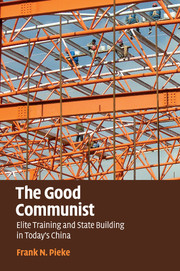Book contents
- Frontmatter
- Contents
- List of illustrations
- Preface
- Map 1 The People's Republic of China
- Map 2 Yunnan Province
- 1 Socialism, capitalism and the anthropology of neo-socialist rule
- 2 Cadres, cadre training and party schools
- 3 Cadre training and education in the twenty-first century
- 4 Life and work at party schools
- 5 Marketization and centralization of cadre education and training
- 6 Cadre training, cadre careers and the changing composition of China's political elite
- 7 Conclusions: cadre training and the future of party rule
- Appendix 1 List of interviewees
- Appendix 2 Student questionnaire survey
- Appendix 3 Glossary of Chinese terms
- References
- Index
7 - Conclusions: cadre training and the future of party rule
Published online by Cambridge University Press: 29 March 2010
- Frontmatter
- Contents
- List of illustrations
- Preface
- Map 1 The People's Republic of China
- Map 2 Yunnan Province
- 1 Socialism, capitalism and the anthropology of neo-socialist rule
- 2 Cadres, cadre training and party schools
- 3 Cadre training and education in the twenty-first century
- 4 Life and work at party schools
- 5 Marketization and centralization of cadre education and training
- 6 Cadre training, cadre careers and the changing composition of China's political elite
- 7 Conclusions: cadre training and the future of party rule
- Appendix 1 List of interviewees
- Appendix 2 Student questionnaire survey
- Appendix 3 Glossary of Chinese terms
- References
- Index
Summary
CADRE TRAINING, THE PARTY-STATE AND ANTHROPOLOGY
One of the most striking aspects of cadre training and education is how much it is suffused with a discourse on (if not an obsession with) modernity. At the most general level, this takes the familiar shape, common to all reform policies and a linear descendant of the CCP's May Fourth roots, of an unchallengeable belief that China should progress from a state of backwardness and weakness to one of strength and modernity. Of course, the reforms also buy off political discontent with the material fulfilment of the consumerist desires of middle-class life, but the key of the success of the reforms is that they have delivered, or promise to deliver, the completion of China as a modern nation – strong, unified and prosperous – that will at last right all the wrongs that China has suffered in the course of 150 years of humiliation since the Opium War in 1840. What makes this discourse on modernization irresistible to almost all Chinese is that differences in modernity also imply and justify inequalities in status and power: the discourse on modernity not only liberates, but also locks its subjects into a hierarchical vision of the world. The hierarchical nature of the Chinese concept of modernization entails that modernity is always elsewhere: modernization means trying to improve one's place on the ladder of modernity by trying to become like other, more modern places, people, institutions or nations.
- Type
- Chapter
- Information
- The Good CommunistElite Training and State Building in Today's China, pp. 180 - 195Publisher: Cambridge University PressPrint publication year: 2009

